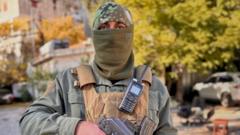In the once-feared city of Latakia, as the sun dipped beneath the horizon, life transformed drastically following the overthrow of Bashar al-Assad's regime. Noor, an Alawite, stood in a dimly lit courtyard trembling—not from the January chill but from the fear that has engulfed her community. Seeking justice from Hayat Tahrir al-Sham (HTS), the newly established ruling force, she faced a grim reminder of her recent traumatic experience.
Three nights prior, armed men in a black van stormed her home, evicting her family under the shroud of darkness. The leader of these men had ruthlessly taken over her apartment, forcing her children and army officer husband rudely out into the night while claiming her possessions for his own.
Noor, whose name has been concealed for her safety, is emblematic of the apprehension pervading Latakia's Alawite heartland—a region home to a sect that constituted the backbone of the Assad regime. With Alawites making up roughly 10% of Syria’s majority Sunni population, Latakia embodied a confluence of sectarian loyalty and fear of forthcoming scapegoating.
As various rebel factions scrambled to fill the power void left by the Assad military, local communities found themselves navigating a treacherous landscape. Despite a promise from HTS to respect all faiths, many Alawites remained entrenched in fear of retribution for their past affiliations. A growing number of residents refuse to step foot outside, wary of potential backlash for their support of the previous regime.
Inside the HTS security station—once the terrifying bastion of the former military intelligence—a different reality emerged. The air was thick with tension as Abu Ayoub, an HTS commander, listened to Noor recount her harrowing tale while watching surveillance footage of the assailants on her doorstep. The transformation of these rebel fighters from insurgents to enforcers of a new law underscores the starkshift in power dynamics over mere weeks.
Meanwhile, another complainant, bearing visible injuries, recounted an equally distressing encounter with armed assailants who robbed and assaulted his family in their own home. As HTS embarked on apprehending the suspects, the community was rapidly becoming a theater for this tense struggle for law and order amidst chaotic beginnings.
With previous governance dismantled, adjacent neighborhoods have become battlegrounds of violence, and Abu Ayoub confirmed the rising unrest that infiltrates the streets. He likened the ongoing chaos to a necessary growing pain and promised Noor the return of her belongings, albeit aware of the looming shadows of distrust that still permeated relationships in the neighborhood.
Latakia celebrated the regime's downfall, yet the future remained clouded with fear and divisions. As the men in pickup trucks careened through the streets adorned with the new Syrian flag, the mood shifted significantly in predominantly Alawite areas. Noor's newfound “liberation” was overshadowed by a grim apprehension of retribution for the past.
HTS faces an uphill battle in restoring order amid a backdrop of deep-seated tensions. As they dispatch officers to restore a sense of safety, the haunting memories of sectarian violence and oppression loom heavily over every community member. "There is always hope," Noor stated, clutching her belongings with despair. Yet for now, she and many like her would remain unwilling to return to a home now synonymous with fear, marked as a site where yesterday’s nightmares had merely dissolved into today’s uncertainty.

















